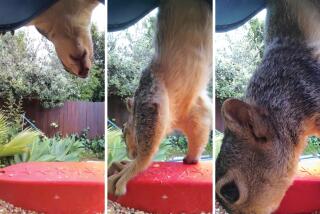SILENT SENTINELS
IRVINE — Rafael Rodriguez Aranda’s creations were born of necessity. Hungry birds were pecking the seeds from strawberries growing in the Pinnacle Farms fields near the El Toro Marine Corps Air Station, leaving the berries scarred, pocked and unfit for picking.
So Rodriguez, a field hand, went to work.
Using branches and twigs, plastic scraps and found pieces of clothing, Rodriguez created a small detachment of stick soldiers. With each stir of a breeze, the sentinels flap gently, as though coming to life, a flutter of activity that spooks the marauders into flying off.
Ornate, involved creations, Rodriguez’s scarecrows seem disconcertingly real from a distance, which of course is the whole point. As they repel birds, they draw the attention of other creatures--passing motorists, who often crane their necks, seeing in Rodriguez’s work something more than a simple farm trick.
“Many people have told me this is a work of art that you’re doing,” Rodriguez, 43, said as he stood at field’s edge in the sun of a late spring afternoon. “I see them as something I put out there to do my work. But if I were to analyze the scarecrows that I make, I can see what they mean. I like them. They please me.”
America’s transition from an agrarian society to an industrial society to a post-industrial society has never been marked by clear lines. Which may be why Rodriguez’s scarecrows, and those that farm workers have created in other fields around Orange County, can be so appealing. They form a physical link to a fading past, rural icons of a different time in this same place.
“They’re fun things, really,” said Avon Neal of Brookfield, Mass., whose travels around the world have led to two books about scarecrows, both now out of print. “They’re the epitome of a folk art form, because they’re made for utilitarian purposes and they become things of beauty, really, within their own provenance.”
*
They are things of tradition, as well, even though few scholars have explored the history of scarecrows. The Smithsonian Institution, with its millions of artifacts of American history, doesn’t have any in its collection, other than the suit Ray Bolger wore in “The Wizard of Oz.”
Neal suspects scarecrows gather such little serious interest because they are so pervasive.
“In the U.S., it’s a tradition probably brought over from Central Europe,” Neal said. “They’ve been in use since the beginnings of colonial America. . . . It’s still a tradition in all the agrarian areas of the world.”
Neal said he and his wife recently returned from a trip to Egypt with photographs of yet more scarecrows, these standing in fields along the banks of the Nile.
“They were really creative,” he said, “a prime example of folk art.”
Yet on the practical end, even Neal is a doubter.
“People truly believe that they make a difference and keep the birds away,” he said. “My feeling is they’re more ornamental.”
Paul Gorenzel, a staff research associate in UC Davis’s cooperative extension office, has studied various ways of driving birds from fields--including noisemakers, sun-reflecting Mylar tape and propane-fueled cannons.
There’s only one sure-fire method: a human presence. Scarecrows might be the next best thing, he said, but they only work temporarily.
“When you put something out there that looks like a person, an animal will be wary of it,” Gorenzel said. “They will quickly learn that there’s no real harm or danger, and after a while they’ll fail to respond to it.”
Rodriguez’s faith in scarecrows is less academic. He knows they work because he has seen them work.
“What works best is when the figures have a movable part, like the hands,” he said. He relies on wind for the effect, attaching a glove, for example, so that it will flit in the breeze like the flip of a hand. “That’s what scares the birds. That’s the fright.”
There’s a method involved, tactics Rodriguez developed through close familiarity with the birds. You only need to scare one bird, Rodriguez said, to roust the whole flock.
The tricks were learned on the land. Rodriguez was born and raised in Guanajuato, Mexico, a state northwest of Mexico City that he described as similar to south Orange County--steep desert hills giving way to green valleys with fields filled with lettuce, tomatoes and strawberries.
He was about 5, he said, when he first went into the fields with his father.
“That’s how I learned everything about the earth and the plants and the birds and what would harm them and what would help them,” Rodriguez said. “I like my work very much. In Mexico, that’s what one has, his work.”
*
Rodriguez, who lives with his wife in Santa Ana, has worked for Pinnacle Farms since 1979, he said. In the past, farm managers used different methods to scare off birds, including most recently using farm workers as human deterrents, sending them into the fields to shoo away the flocks.
This year, they turned to Rodriguez’s art, and the occasional crack of the bullwhip. The few times those don’t work, Rodriguez simply feeds the birds, laying out flats of seeds for easy picking that draws them away from the berries in the fields.
Rodriguez, who builds the scarecrows as part of his regular work in the fields, takes grudging pride in his creations. They are art, he finally agrees, simply because they are what they are.
“Art is something that comes from inside,” he said, “and I do feel something for my scarecrows.”
More to Read
The biggest entertainment stories
Get our big stories about Hollywood, film, television, music, arts, culture and more right in your inbox as soon as they publish.
You may occasionally receive promotional content from the Los Angeles Times.











